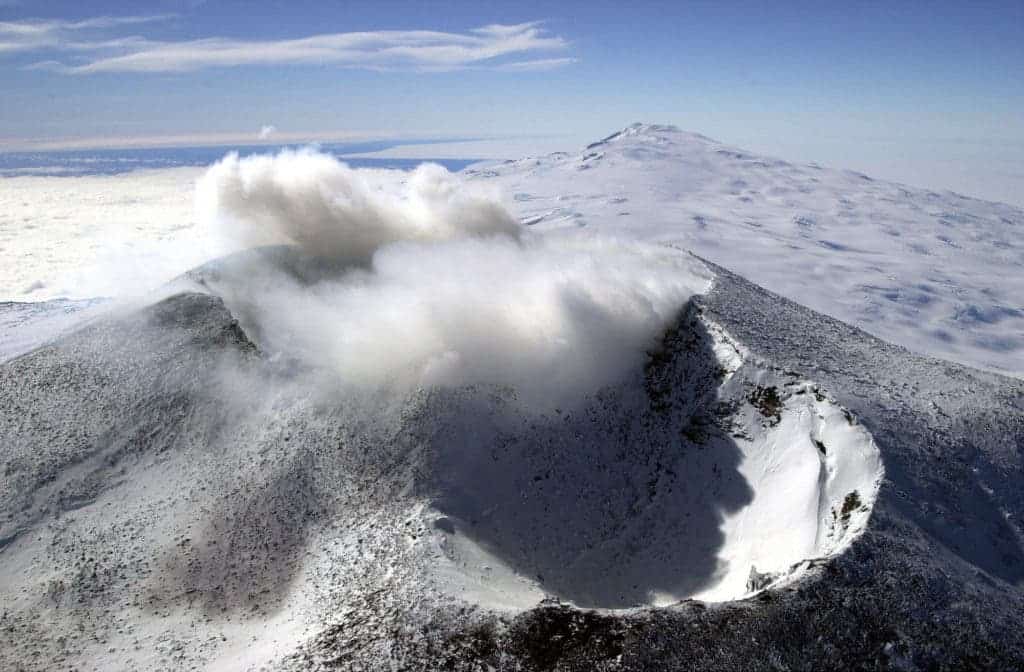“You could wear a T-shirt in there and be pretty comfortable,” researchers say.

A T-shirt… yeah. In Antarctica’s frozen wasteland, Mount Erebus has been active for over 1 billion years. Credits: United States Antarctic Program.
Fire and ice
About 98% of Antarctica is covered by ice that averages 1.9 km (1.2 mi) in thickness, with average temperatures ranging from -10°C (14F) on the warmer coasts to -55C (-67F) deeper inland. But somewhere beneath this barren surface, researchers found a warm, potentially habitable oasis.
Located under and around the Mount Erebus, a volcano named for the primordial deity of darkness, a hidden system of ice caves hosts temperatures that go up to 25C. Two extremes — Antarctica’s cold and the volcano’s heat — work together to create surprisingly pleasant conditions.
“You could wear a T-shirt in there and be pretty comfortable,” lead researcher Ceridwen Fraser said. “There’s light near the cave mouths, and light filters deeper into some caves where the overlying ice is thin.”
Fraser and colleagues from the Australian National University conducted forensic studies of the soil inside the caves, finding tantalizing DNA evidence of algae, mosses and small animals. While they haven’t yet seen these creatures, researchers believe there’s a very good chance the caves host a solid ecosystem. Fraser says some of the DNA sequences belong to unknown species.
“That might just be because there are plants and animals in Antarctica that we haven’t sequenced at those parts of the genome before, so they might just be your bog-standard plants and animals from Antarctica, or they might indicate something more exciting, like species that we don’t know anything about yet,” she said.
“There was one set of sequences that look like they’re from some sort of arthropod, and arthropods are things like spiders, mites, a lot of insects … You could imagine maybe a cave mite or some sort of insect-like organism that’s down there.”
However, while this is extremely exciting, it’s important to keep our feet on the ground. Just because DNA was found there doesn’t mean that creatures are still living there, warns Professor Laurie Connell from the University of Maine, who was also involved in the study. The next steps of the study will be crucial, as biologists will try to actually find the animals.
A potential explanation for the DNA existing there would be Antarctica’s strong winds, which might bring organic matter from far away. The bottom line is we won’t actually know for sure until we look.
Life finds a way
But it’s completely conceivable that there might be species living under the ice in Antarctica. We already know that diverse bacterial and fungal communities inhabit the caves in Antarctica, so it would only make sense for some higher creatures to also exist. If they do, understanding how they evolved to adapt to this special environment will open a new area of research for years to come.
There might also be many more ice caves to discover. With a summit elevation of 3,794 meters (12,448 ft), Mount Erebus has been active for over one billion years and we don’t really know how many more caves were created by its heat — or how interconnected they are. Unfortunately, that they’re really difficult to explore from ground level due to obvious reasons.
In a separate project, researchers are working on developing a 3D model of Mt Erebus’ plumbing, or magmatic system, from source to surface. This model could help predict some of the caves, or at least the structure and connectivity of the cave system. LiDAR data could also help, though at the end of the day, nothing will replace good old fashioned boots on the ground.
Journal Reference: Ceridwen I. Fraser, Laurie Connell, Charles K. Lee, S. Craig Cary. Evidence of plant and animal communities at exposed and subglacial (cave) geothermal sites in Antarctica. doi:10.1007/s00300-017-2198-9










